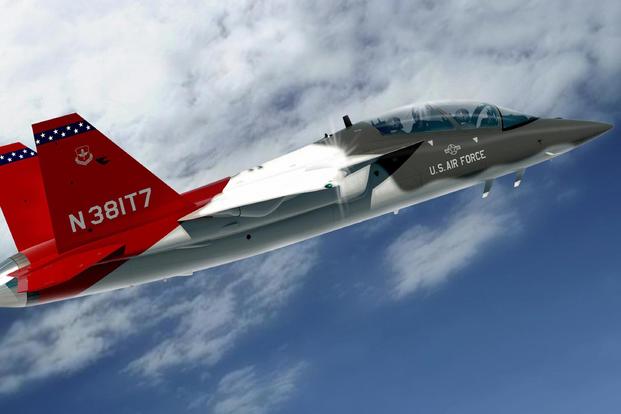Boeing Co. has begun production on simulators that will help train the U.S. Air Force's next generation of pilots.
In a step forward for the Air Force's transition to the T-7A Red Hawk advanced jet trainer, the aerospace company announced Dec. 1 it had begun assembling the first two weapons systems trainers and an operational flight trainer at its St. Louis, Missouri facility.
Read Next: No, ‘The Kraken’ Does Not Refer to a Military Intelligence Unit, Army Says
Once constructed, the simulators will be able to "digitally connect to the actual T-7A cockpit," enabling pilots practicing in the virtual simulation to connect with pilots flying the T-7 during live training, the company said.
"This system is 100% integrated with the pilot's real-world experience, offering real-as-it-gets simulation," Chuck Dabundo, vice president, Boeing T-7 Programs, said in the release. "We're working closely with the U.S. Air Force and look forward to testing and fielding the devices."
The Air Force awarded Boeing Co. a $9.2 billion contract in Sept. 2018 to build a new single-engine aircraft for training pilots, in a program known as T-X. In 2019, the Air Force rebranded T-X as the T-7A Red Hawk, named in honor of the Tuskegee Airmen. The first T-7A is expected to be delivered in 2023, along with its simulators.
The simulators will be built with an open-system architecture of hardware and digital software, allowing the plane's software to be upgraded and installed more easily than legacy training systems, the company says.
The simulators will offer high-fidelity and high-definition visual displays to give pilots a near replica of what they would see and experience in flight. The company said the sims will be equipped with motion seats and a Boeing-made visual system using 8K native projectors offering clarity 16 that of standard high-definition 1080p video.
"This is the most accurate, immersive experience that any pilot can have outside the cockpit," said Sherri Koehnemann, T-7A Training & Sustainment director at Boeing Global Services, in a statement.
"We've integrated the training across the board, including 'one push' software updates," Koehnemann added. "What a pilot sees in the classroom, on his or her desktop training devices, and in the operational and weapon systems trainers will be what they see in the jet. Future pilots can expect more holistic, immersive training."
The new trainers will replace the Air Force's current Northrop Grumman-made T-38 Talons, some of which date to the mid-1960s.
The service has committed to buying 351 T-7A jets, 46 simulators and associated ground equipment.
The payment structure, officials have said, also allows for an indefinite-delivery, indefinite-quantity option, giving the Air Force the opportunity to purchase up to 475 aircraft and 120 simulators.
-- Oriana Pawlyk can be reached at oriana.pawlyk@military.com. Follow her on Twitter at @Oriana0214.
Related: The Air Force Wants to Overhaul Pilot Training. But It Has to Win Over the Skeptics First













